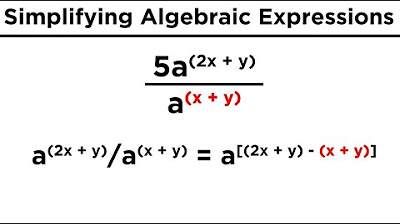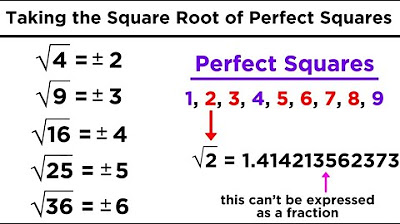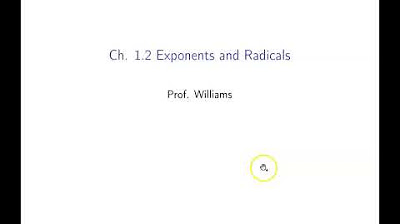Algebra Basics: Exponents In Algebra - Math Antics
TLDRIn this Math Antics video, Rob introduces the fundamentals of exponents and roots in the context of Algebra, contrasting them with their Arithmetic counterparts. He explains the pattern of 'x' raised to the 'n'th power, emphasizing the importance of non-negative integers for 'n'. Rob highlights key exponent rules, such as any number to the 0th power equals 1 and to the 1st power is itself. The video demonstrates solving basic algebraic equations involving exponents and roots, showcasing the inverse relationship between them. It also addresses the concept of positive and negative solutions for equations with even roots, and the uniqueness of solutions for odd roots, providing clear examples and reinforcing the importance of practice in mastering these algebraic concepts.
Takeaways
- 📚 Exponents and roots are fundamental in both arithmetic and algebra, but algebra introduces unknown values and variables.
- 🔢 Algebraic expressions often use variables like 'x' raised to various powers, unlike arithmetic which uses specific numbers.
- 🤔 The main goal in algebra is to determine the values of these unknown variables.
- 📈 The pattern 'x' to the 'n'th power, where 'n' is an integer, is a key concept in algebra, with 'n' limited to non-negative integers for simplicity.
- 💡 'x' squared means 'x' multiplied by itself, and 'x' cubed means 'x' multiplied by itself three times, with this pattern extending to higher powers.
- 🎯 'x' to the 1st power is simply 'x', which aligns with the identity property of multiplication where any number multiplied by 1 is itself.
- 🌟 'x' to the 0th power equals 1, which may seem counterintuitive but is consistent with the identity property of multiplication involving a factor of 1.
- 🧙♂️ To solve equations with roots, use the inverse operation, which is raising to the corresponding power.
- 🔑 Squaring the square root of 'x' cancels out the operations, leaving just 'x', which is a method to isolate the variable.
- 📉 For equations with exponents, such as 'x' squared equals a number, taking the square root of both sides cancels out the exponent, isolating 'x'.
- 🔍 Even roots can have both positive and negative solutions, while odd roots only have one solution, as demonstrated with the cube root of 27 being 3, not -3.
Q & A
What is the main difference between Arithmetic and Algebra?
-The main difference between Arithmetic and Algebra is that Algebra involves unknown values and variables, whereas in Arithmetic, you deal with specific numbers and no variables.
How are exponents used in Algebra compared to Arithmetic?
-In Algebra, exponents are used with variables, such as 'x to the n-th power', where 'n' is an integer. In Arithmetic, exponents are used with specific numbers, like '4 squared'.
What is the pattern for 'x' to the n-th power?
-The pattern for 'x' to the n-th power is that 'x' is multiplied together 'n' times. For example, 'x to the 2nd power' is 'x multiplied by x', and 'x to the 3rd power' is 'x multiplied by x and then by x'.
What does 'x' to the 0th power represent?
-'x' to the 0th power represents '1', which is a factor of '1' in any multiplication problem.
How can you solve for 'x' in the equation 'the square root of x = 3'?
-To solve for 'x' in the equation 'the square root of x = 3', you need to square both sides of the equation to cancel out the square root, resulting in 'x = 3'.
What is the inverse operation to a root?
-The inverse operation to a root is an exponent. To undo a root, you use its corresponding exponent.
Why can't you use the square root of both sides when solving 'the cube root of x = 5'?
-You can't use the square root of both sides when solving 'the cube root of x = 5' because the cube root operation is not the inverse of the 3rd power. Instead, you need to cube both sides to cancel out the cube operation and isolate 'x'.
What is the rule for dealing with equations involving both exponents and roots?
-When dealing with equations that involve both exponents and roots, you undo the root with its corresponding exponent and vice versa. This is because roots and exponents are inverse operations.
Why does the square root of 36 have two solutions, +6 and -6?
-The square root of 36 has two solutions, +6 and -6, because the rule for multiplying and dividing integers states that the product of two negative numbers is positive. This means that 'negative 6' times 'negative 6' equals 36, just as '6' times '6' does.
What is the cube root of 27 and why can't x = -3 be a valid solution to 'x cubed = 27'?
-The cube root of 27 is 3 because 3 multiplied by 3 multiplied by 3 equals 27. x = -3 cannot be a valid solution because if you multiply -3 by -3 by -3, the result is -27, not 27. Therefore, there is only one solution to 'x cubed = 27', which is x = 3.
What is the significance of the 'plus or minus sign' in algebraic equations?
-The 'plus or minus sign' in algebraic equations is used when a solution could be positive or negative. It indicates that the solution space includes all possible values that satisfy the equation, such as 'x = + or - 6' for 'x squared = 36'.
Outlines
📚 Introduction to Algebraic Exponents and Roots
The video script introduces the concept of exponents and roots in the context of Algebra, highlighting the difference between arithmetic and algebraic expressions. It explains that while arithmetic deals with known numbers, algebra involves variables and unknown values. The script emphasizes the pattern formed by 'x' raised to the 'n'th power, where 'n' is a non-negative integer. It also discusses the meaning of exponents, starting with 'x' squared and 'x' cubed, and explains that any number to the 1st power is itself, similar to the identity property of multiplication. The video then delves into the concept of 'x' to the 0th power, which surprisingly equals 1, and relates this to the identity property of multiplication where a factor of '1' is always present. This section sets the stage for understanding exponents in algebra and their application in solving equations involving roots and exponents.
🔍 Solving Basic Algebraic Equations with Roots and Exponents
This section of the script focuses on solving basic algebraic equations that involve roots and exponents. It begins with the equation 'square root of x = 3' and explains the process of isolating the variable 'x' by eliminating the square root sign using its inverse operation, which is squaring. The script demonstrates that squaring both sides of the equation leads to 'x = 9'. It then moves on to solving equations with cube roots, such as 'cube root of x = 5', by cubing both sides to isolate 'x', resulting in 'x = 125'. The script also addresses equations with exponents, like 'x squared = 36', and shows that taking the square root of both sides cancels out the exponent, yielding 'x = 6'. However, it also introduces the concept of negative solutions due to the multiplication of negative numbers resulting in positive products, leading to the conclusion that 'x' could be both 6 and -6. This part of the script provides a clear methodology for solving simple algebraic equations involving roots and exponents, emphasizing the importance of considering both positive and negative solutions.
📘 Understanding Exponent Rules and Solving Equations with Odd and Even Roots
The final paragraph of the script wraps up the lesson on exponents and roots by summarizing the two key rules learned: any number to the 0th power is 1, and any number to the 1st power is itself. It also revisits the process of solving equations with roots and exponents, emphasizing the use of corresponding exponents to undo roots and vice versa. The script explains the difference between solving equations with even roots, which can have both positive and negative solutions (e.g., 'x = ±6' for 'square root of 36'), and odd roots, which do not have negative solutions when the original number is positive (e.g., 'x cubed = 27' has only one solution, 'x = 3'). The video concludes by encouraging viewers to practice these concepts through exercise problems to solidify their understanding of exponents in algebra. It also provides a resource for further learning at www.mathantics.com.
Mindmap
Keywords
💡Algebra
💡Exponents
💡Variables
💡Roots
💡Square root
💡Cube root
💡Zeroth power
💡First power
💡Inverse operations
💡Equation solving
💡Plus or minus sign
Highlights
Introduction to the use of exponents and roots in Algebra.
Algebra involves unknown values and variables, unlike Arithmetic.
The concept of 'x' squared in Algebra as opposed to '4 squared' in Arithmetic.
Roots in Algebra are represented as the square root of 'X'.
The goal in Algebra is to determine the unknown values.
Pattern formed by 'x' to the 'n'th power, where 'n' is any integer.
Limitation of 'n' to non-negative integers for simplicity.
Explanation of 'x' to the 0th, 1st, and 2nd power.
Rule that any number raised to the 1st power is itself.
Surprising rule that any number raised to the 0th power equals '1'.
Inclusion of a factor of '1' in the pattern of exponents.
Importance of understanding exponent rules in Algebra.
Solving the equation 'square root of x = 3' by squaring both sides.
Using the inverse operation to eliminate the square root sign.
Solving the cube root equation 'cube root of x = 5' by cubing both sides.
Undoing an exponent with a corresponding root.
Solving 'x squared = 36' by taking the square root of both sides.
Understanding that square roots can have both positive and negative solutions.
Use of the 'plus or minus' sign for even roots.
Solving 'x cubed = 27' and understanding that odd roots do not have negative solutions.
Summary of the two important exponent rules: 0th and 1st power.
Emphasis on practicing to understand exponents and roots in Algebra.
Transcripts
Browse More Related Video

Simplifying Expressions With Roots and Exponents

Solving Algebraic Equations With Roots and Exponents

Square Roots, Cube Roots, and Other Roots

Ch. 1.2 Exponents and Radicals

Algebra Basics: Solving Basic Equations Part 1 - Math Antics

Using Substitutions to Solve Equations (Precalculus - College Algebra 23)
5.0 / 5 (0 votes)
Thanks for rating: